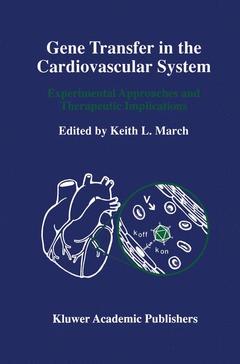Description
Gene Transfer in the Cardiovascular System, Softcover reprint of the original 1st ed. 1997
Experimental Approaches and Therapeutic Implications
Developments in Cardiovascular Medicine Series, Vol. 189
Coordinator: March Keith L.
Language: English
Subject for Gene Transfer in the Cardiovascular System:
Keywords
Publication date: 10-2012
516 p. · 15.5x23.5 cm · Paperback
516 p. · 15.5x23.5 cm · Paperback
Description
/li>Contents
/li>
The goal of gene transfer is protein expression. a process brought about by the insertion of a gene coding for a foreign protein into target cells resulting in the synthesis of the foreign protein For gene therapy, a tmnsferred therapeutic gene must be expressed at a level beneficial for the patient. This chapter provides an introductory overview of the rapidly evolving field of non-viral approaches for gene delivery to rnarnrnalian cells. Although currently there are fewer ongoing clinical trials using non-viral approaches than those using viral based systems, the number of non-viral trials is increasing. The long range goal of some research groups is the development of a genetically engineered artificial virus targeted to specific cells in the human body. An arurual conference, organized by Cambridge Healthtech Institute entitled "Artificial Self-Assembling Systems for Gene Transfer", brings together researchers interested in this field [1]. Assembly of an artificial virus is very complex; other research groups aim to develop simpler delivery systems consisting of a plasmid combined with delivery agents. Viral-based systems are very successful for gene delivery, but despite their successes, viral-based systems have some geneml limitations and system-specific limitations. When employing a viml-based system, the following limitations should be considered: ? size limitation of the inserted gene due to packaging constraints (e. g. adenovirus, retrovirus) . ? potential tumorigenesis (e. g. retrovirus) ? potential for insertional mutagenesis (greater than plasmid based systems) ? potential imrnunogenicity (e. g.
Vectors and Gene Transfer Systems: Molecular Aspects of Delivery.- 1. Development of Viral Vectors for Human Gene Therapy: Retrovirus and Adenovirus (Part I).- 2. Adenoviruses (Part II): Improvement of Adenoviral Vectors for Human Gene Therapy: E1 and E4 Deleted Recombinant Adenoviruses.- 3. Adeno-associated Virus and Other New DNA Virus Vectors.- 4. Plasmid and Other Non-Viral Vectors.- 5. The HVJ/Liposome Molecular Delivery System for In Vivo Genetic Engineering.- 6. Endogenous Expression Modification: Antisense Approaches.- Methods for Localizing Gene Transfer: Mechanical Aspects of Delivery.- 7. Catheter-Based Local Drug and Gene Delivery.- 8. Fluid Dynamics of Catheter Delivery: Effects on Delivery Efficiency and Localization.- 9. Targeted and Sustained-Release Delivery Concepts in Gene Therapy.- Gene Delivery for Local Vascular Expression.- 10. Viral Vector-Based Vascular Gene Delivery: Basic Studies and Therapeutic Applications.- 11. Cell-Based Vascular Gene Delivery: Endothelial Cells as Carriers.- 12. Cell-Based Gene Delivery: Smooth Muscle Cells as Carriers.- 13. Vascular Cell Proliferation Dynamics: Implications for Gene Transfer and Restenosis.- 14. Angiogenesis and Collateral formation.- Gene Delivery for Local Cardiac Expression.- 15. Cell-Based Myocardial Protein Delivery.- 16. Skeletal Myoblast Therapy in Cardiovascular Disease.- 17. Adenovirus and the Myocardium.- Gene Delivery for Systemic Expression.- 18. Gene Delivery for Systemic Expression: Plasmid, Retroviral, and Adenoviral Approaches.- 19. Adenoviral Gene Delivery Approaches for Systemic Expression.- 20. Experimental Approaches Using Kallikrein Gene Therapy for Hypertension.- Biophysical Considerations in Vector Delivery.- 21.Pharmacokinetics of Local Vector Delivery To Vascular Tissues: Implications for Efficiency and Localization.- Color Plates.
© 2024 LAVOISIER S.A.S.

